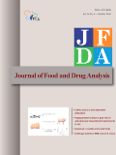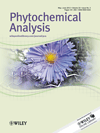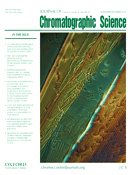
JPC-JOURNAL OF PLANAR CHROMATOGRAPHY-MODERN TLC
Scope & Guideline
Connecting Researchers to Cutting-Edge TLC Insights.
Introduction
Aims and Scopes
- Development of High-Performance Thin-Layer Chromatography Methods:
The journal emphasizes the development and validation of high-performance thin-layer chromatography methods for quantifying various compounds, including pharmaceuticals, phytochemicals, and food constituents. - Application of Green Analytical Chemistry:
There is a strong focus on sustainable and eco-friendly analytical practices, including the use of green solvents and methods that minimize environmental impact. - Phytochemical Analysis and Herbal Standardization:
The journal publishes studies on the chemical profiling, standardization, and quality assessment of herbal products and traditional medicines, highlighting the importance of bioactive compounds. - Quality Control and Stability Studies:
Research on the stability-indicating methods for pharmaceuticals and the quality control of various products is a core area, with methodologies that assess degradation and ensure product integrity. - Innovative Analytical Techniques:
The journal also explores novel analytical techniques, including the integration of TLC with mass spectrometry and other advanced methodologies to enhance the analytical capabilities.
Trending and Emerging
- Integration of Multi-Stage Mass Spectrometry:
There is an increasing trend towards combining TLC with multi-stage mass spectrometry, enhancing the sensitivity and specificity of analyses, particularly for complex matrices. - Focus on Bioactivity and Pharmacokinetics:
Emerging research is concentrating on the bioactivity of phytochemicals and pharmacokinetic studies, emphasizing the importance of understanding the therapeutic potential and behavior of compounds in biological systems. - Analytical Quality by Design (AQbD):
The application of AQbD principles in developing robust analytical methods is gaining popularity, as researchers aim to improve method reliability and efficiency while adhering to regulatory standards. - Digital Imaging and Chemometrics:
The use of digital imaging techniques and chemometric approaches for data analysis in TLC is on the rise, providing more sophisticated ways to interpret chromatographic data. - Herbal Medicine and Nutraceutical Analysis:
There is a growing interest in the analysis of herbal medicines and nutraceuticals, with a focus on standardization, quality control, and the quantification of bioactive constituents.
Declining or Waning
- Traditional Analytical Methods:
There is a noticeable decline in studies focused solely on conventional thin-layer chromatography methods without any enhancements or modern adaptations, as researchers increasingly seek advanced methodologies. - Non-Eco-Friendly Practices:
Research that does not incorporate eco-friendly practices or green chemistry principles is becoming less common, as there is a growing emphasis on sustainability in analytical chemistry. - Basic Qualitative Analyses:
Papers that focus primarily on basic qualitative analysis without quantitative aspects or detailed validation are witnessing decreased publication frequency, reflecting a shift towards more comprehensive and quantitative studies.
Similar Journals

Pakistan Journal of Analytical & Environmental Chemistry
Pioneering Research for a Cleaner TomorrowPakistan Journal of Analytical & Environmental Chemistry, published by the University of Sindh, National Centre of Excellence Analytical Chemistry, is a distinguished platform that has been committed to promoting high-quality research in the fields of analytical and environmental chemistry since its inception. With an ISSN of 1996-918X and an E-ISSN of 2221-5255, this journal has established itself as an open-access resource since 2007, facilitating the dissemination of knowledge to a global audience. Acknowledged for its contributions, the journal currently holds a Q4 category ranking in both Analytical Chemistry and Environmental Chemistry as of 2023, with Scopus rankings placing it within the challenging competitive bracket. The journal aims to publish original research, reviews, and technical notes that elucidate contemporary challenges and advancements, making it an essential read for researchers, professionals, and students who are exploring innovative methodologies and solutions in chemical analysis and environmental monitoring. By fostering a collaborative research environment and encouraging multidisciplinary approaches, the Pakistan Journal of Analytical & Environmental Chemistry plays a crucial role in advancing the field and addressing environmental concerns in Pakistan and beyond.

Acta Chemica Iasi
Unlocking Knowledge, Inspiring DiscoveryActa Chemica Iasi is a distinguished open-access journal dedicated to advancing the field of chemistry, published by the esteemed ALEXANDRU IOAN CUZA UNIVERSITY PRESS located in Iasi, Romania. Since its inception, this journal has served as a vital platform for the dissemination of significant research findings, theoretical advancements, and methodological innovations in various chemistry disciplines. As an open-access publication since 2013, it provides unrestricted access to high-quality articles, fostering collaboration and knowledge sharing among researchers, professionals, and students globally. Although specific metrics such as H-Index and Scopus rankings may be forthcoming, the journal's commitment to rigor and excellence ensures that it remains an invaluable resource for those seeking to stay at the forefront of chemical research. With a focus on promoting scientific inquiry and innovation, Acta Chemica Iasi continues to uphold a legacy of scholarly excellence and contribution to the chemical sciences.

JOURNAL OF FOOD AND DRUG ANALYSIS
Unveiling Research at the Intersection of Food and PharmacologyJOURNAL OF FOOD AND DRUG ANALYSIS, an esteemed publication in the realms of Food Science and Pharmacology, is published by DIGITAL COMMONS BEPRESS. With an impactful commitment to open access since 2013, this journal facilitates the dissemination of critical research findings, making them readily available to a global audience. Boasting a commendable Q2 ranking in both Food Science and Pharmacology, the journal occupies a prominent position in its respective categories, reflecting its quality and relevance in the field. Established in 1994, the journal has successfully converged its focus to encompass a wide range of topics related to the analysis of food and drugs, thereby providing valuable insights to researchers, practitioners, and students alike. With its indexed indicators in Scopus showcasing a strong performance—ranking #85 among 389 in Food Science and #108 among 313 in Pharmacology—it stands as a crucial platform for the advancement of knowledge and innovation. For those looking to stay abreast of pivotal developments in food safety and drug efficacy, JOURNAL OF FOOD AND DRUG ANALYSIS is an indispensable resource.

PHYTOCHEMICAL ANALYSIS
Pioneering Analytical Methods for Phytochemical DiscoveryPHYTOCHEMICAL ANALYSIS is a renowned journal published by WILEY that serves as a vital resource in the fields of analytical chemistry, biochemistry, and plant sciences, among others. With an ISSN of 0958-0344 and an E-ISSN of 1099-1565, this journal has been at the forefront of phytochemical research since its inception in 1990, with a commitment to advancing knowledge up to 2024. Notably, it boasts impressive Scopus rankings, including a Q1 quartile in Complementary and Alternative Medicine, highlighting its significant impact in this area. The journal provides essential insights into phytochemical analysis for a diverse audience that includes researchers, industry professionals, and students, thereby facilitating the discovery and application of phytochemicals in various fields such as drug discovery and food science. The journal is not currently open access, yet it remains a pivotal platform for disseminating high-quality research findings. With its focus on interdisciplinary approaches and innovative methodologies, PHYTOCHEMICAL ANALYSIS continues to reinforce its reputation as a cornerstone of contemporary research in plant science and related disciplines.

JOURNAL OF CHROMATOGRAPHIC SCIENCE
Fostering Knowledge for Analytical BreakthroughsWelcome to the Journal of Chromatographic Science, a premier publication dedicated to advancing the scientific understanding of chromatographic techniques and their applications across various disciplines. Published by Oxford University Press Inc, this journal, with its ISSN 0021-9665 and E-ISSN 1945-239X, has been disseminating innovative research since 1963, serving as a vital resource for researchers, industry professionals, and academic scholars in the fields of Analytical Chemistry and Medicine. As evidenced by its 2023 Scopus ranking, the journal stands at the Q3 quartile in both its primary disciplines, highlighting its relevance and contribution to ongoing research. The journal promotes high-quality, peer-reviewed articles that aim to foster knowledge and encourage the practical application of chromatographic science. While it operates under a traditional subscription model, the valuable insights it offers are essential for those seeking to enhance their expertise and stay at the forefront of chromatographic methodologies. Join our community of scholars as we explore the complexities and innovations in chromatographic science, paving the way for future discoveries.

Separations
Advancing the Frontiers of Separation ScienceSeparations is a prestigious open-access journal published by MDPI, dedicated to advancing the fields of analytical chemistry and filtration and separation processes. Established in 2014, the journal has swiftly emerged as a significant platform for disseminating groundbreaking research and innovative methodologies in separation science, boasting an impressive E-ISSN of 2297-8739 and operating out of Basel, Switzerland. With its focus rotating from 2016 through 2024, Separations has been categorized in the Q3 quartile for both analytical chemistry and filtration and separation disciplines as of 2023, demonstrating its relevance in these scientific areas. The journal's rankings in Scopus, with 93rd out of 156 in analytical chemistry and 15th out of 19 in chemical engineering filtration and separation, reflect its commitment to high-quality research accessible to a global audience. Researchers, professionals, and students will find valuable insights and pioneering findings that foster collaboration and innovation within the vibrant community of separation science.

CHROMATOGRAPHIA
Unraveling Complexities through ChromatographyCHROMATOGRAPHIA is a renowned scholarly journal published by Springer Heidelberg, specializing in the field of analytical chemistry, biochemistry, and organic chemistry since its inception in 1968. With its ISSN 0009-5893 and E-ISSN 1612-1112, the journal has maintained a robust profile, currently ranking in the Q3 and Q4 quartiles within significant Chemistry categories. Aimed at researchers, professionals, and students, CHROMATOGRAPHIA serves as a critical platform for disseminating innovative research, methodologies, and advancements related to chromatography and its applications in various scientific fields. While the journal is not open access, it offers significant visibility and scholarly contribution opportunities, making it an essential resource for those engaged in the vibrant intersection of chemistry and biochemistry.

Separation Science Plus
Elevating the standards of separation science research.Separation Science Plus is an emerging academic journal dedicated to advancing the field of analytical chemistry and separation science. Published by WILEY-VCH Verlag GmbH, this journal provides a platform for researchers to disseminate high-quality studies and reviews that address innovative techniques and breakthroughs in separation methodologies. With its ISSN 2573-1815, the journal has made significant inroads since its inception in 2018, encompassing a convergence period until 2024. Despite currently holding a Q3 ranking in Analytical Chemistry and a Q4 ranking in Filtration and Separation, its dedication to publishing impactful research makes it a vital resource for professionals and students alike. The journal operates under the robust scholarly reputation of WILEY, which is known for its commitment to excellence in scientific communication. Researchers interested in the latest advancements in separation techniques will find Separation Science Plus an essential read, fostering the exchange of knowledge and facilitating greater understanding within this specialized field.

Studia Universitatis Babes-Bolyai Chemia
Fostering Innovation in Chemical ResearchStudia Universitatis Babes-Bolyai Chemia, published by UNIV BABES-BOLYAI in Romania, serves as a pivotal platform for the dissemination of innovative research in the field of chemistry. With an ISSN of 1224-7154, this journal has been actively publishing since 2009 and aims to foster scientific collaboration and knowledge sharing among researchers, professionals, and students alike. Although currently categorized in Q4 of the Chemistry (miscellaneous) field, the journal provides an essential venue for emerging studies that contribute to the diverse landscape of chemical research. With its commitment to accessibility and scholarly discourse, Studia Universitatis Babes-Bolyai Chemia remains an important resource for those seeking to stay abreast of the latest developments and trends in general chemistry, holding a Scopus rank within the lower quartiles. Researchers and practitioners are encouraged to engage with its content to enrich their own work and to aid in the advancement of the scientific community.

Food Analytical Methods
Unveiling the science behind food quality and safety.Food Analytical Methods, published by Springer, is an esteemed journal dedicated to the innovative field of analytical methodologies within the food sciences. With an ISSN of 1936-9751 and E-ISSN of 1936-976X, this journal serves as a pivotal platform for researchers and professionals to exchange insights, methodologies, and findings related to food quality analysis, safety measures, and innovative technologies in food science. As of 2023, Food Analytical Methods boasts impressive Scopus rankings, including Q2 in Analytical Chemistry and Food Science, positioning it among the top journals in its category. The journal's commitment to enhancing food safety and quality through rigorous research underscores its importance in both academic and industrial applications. Although it does not currently operate under an open-access model, it provides exceptional value through its rigorous peer-review process and comprehensive publication standards, further inviting contributions from both established and emerging scientists in the field. With coverage spanning from 2008 to 2024, this journal continues to address critical research areas, thereby shaping the future of food analytics.